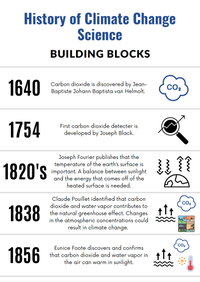Understanding the History of Climate Change Science
Discussions around climate change and the need to address the increase in greenhouse gas emissions globally have recently grown. What is interesting is the importance of maintaining the temperature of the earth’s surface is not a new observation but was first identified in 1827 by Fourier.
October 19, 2022

Discussions around climate change and the need to address the increase in greenhouse gas emissions globally have recently grown. What is interesting is the importance of maintaining the temperature of the earth’s surface is not a new observation but was first identified in 1827 by Fourier.
Followed by Tyndale highlighting in 1859 how methane and carbon dioxide can absorb solar radiation, essentially trapping heat in our atmosphere. Lastly, Arrhenius published in 1896 that industrial activities have the potential to increase global temperature due to the carbon dioxide production. Fast forwarding to the late 1930’s, concerns around the increase in carbon dioxide produced from human activity and warming temperatures was discovered by Stewart Callendar. In order to understand the carbon dioxide levels, measurements started at the Mauna Loa Observatory by Charles Keeling in 1958. It is not long after the evolution of the foundational science and monitoring efforts that scientists behind to predict the increase in the global temperatures and when these specific changes would occur. The Intergovernmental Panel on Climate Change, commonly known as the IPCC, was established to begin understanding the science around climate change.
This panel would go on to produce multiple reports that highlight that the earth has indeed been warming and suggests that this will continue. In the early 2000’s the IPCC publishes that the global warming is unprecedented relative to the last ice age and that human activities are primarily responsible for current climate change. As the science in this area continues to evolve, the panel recommended that “rapid, far-reaching” actions are needed to limit continued global warming at 1.5ºC. The reduction in greenhouse gas emissions continues to be a discuss among the academic community but we are now seeing this topic being including in business decisions and have caught the attention of investors. Science-based targets are one way for an organization to develop a clearly-defined pathway to reduce their greenhouse gas emissions. These efforts will contribute to helping prevent impacts of climate change as well as future-proof business growth.

About the Author
You May Also Like


.png?width=300&auto=webp&quality=80&disable=upscale)